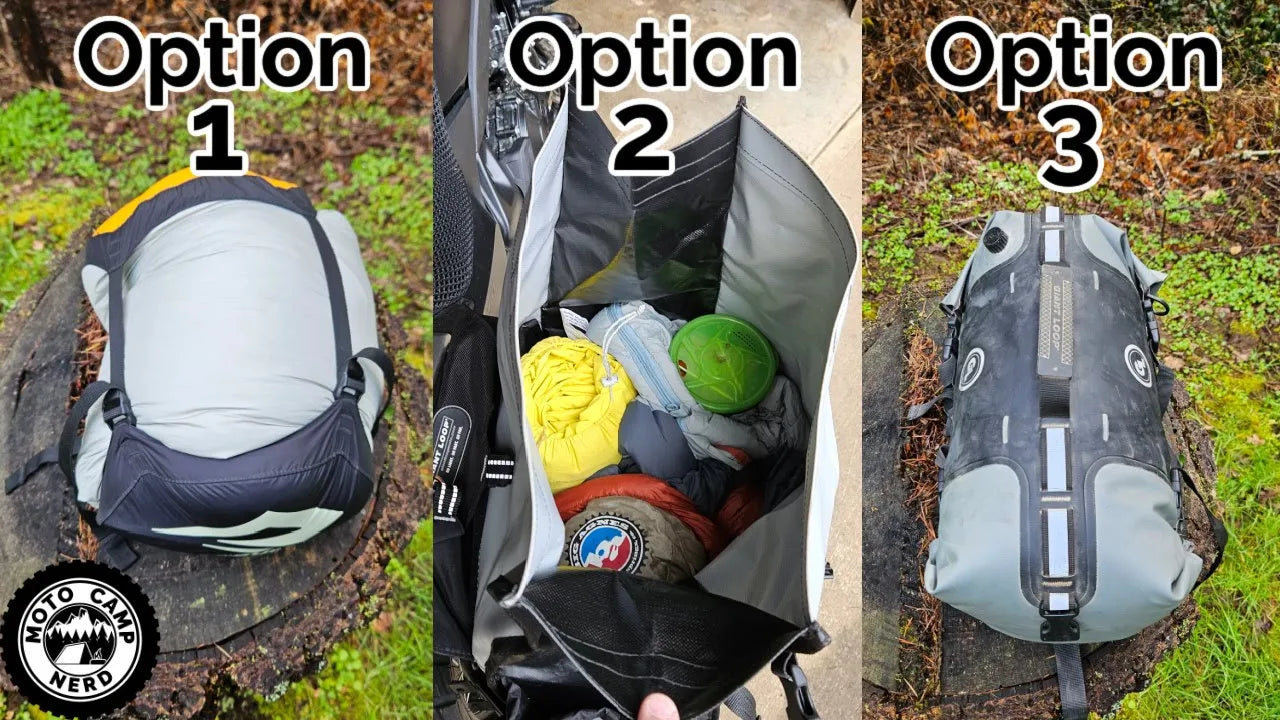When heading out for a motorcycle camping adventure, packing efficiently is key. Your sleeping bag is one of the most essential pieces of gear, but it can also take up significant space. Unlike car camping, where storage is ample, motorcycles require careful planning to balance weight, accessibility, and weather protection. In this guide, we’ll explore three effective ways to pack your sleeping bag so that it remains compact, dry, and easy to transport on your motorcycle.
TLDR: Sroll to the bottom for the video version!
1. The Stuff Sack Method
One of the most common ways to pack a sleeping bag for motorcycle travel is by using a stuff sack, which helps compress the bag and keep it protected from the elements. The key advantage of this method is its compact form, which allows the sleeping bag to fit into small panniers or tail bags. By stuffing the sleeping bag inside rather than rolling it, you allow for better compression, utilizing every bit of available space inside the sack.
For added protection, a waterproof compression sack ensures that even if you encounter rain, your sleeping bag remains dry. This is especially important for motorcycle camping, as exposure to rain or moisture from road spray can quickly make a sleeping bag unusable.
✔️ Pros:
- Compact and easy to store in panniers or tail bags.
- Protects the sleeping bag from moisture and dirt.
- Can be packed inside other luggage compartments for better organization.
❌ Cons:
- Takes up a fair amount of space even when compressed.
- Creates a rigid shape, limiting packing flexibility.
- If not waterproof, exposure to water could lead to a damp sleeping bag.
2. The Pannier Method (No Stuff Sack Needed)
Instead of using a separate stuff sack, this method involves placing the sleeping bag directly into your panniers. By layering other gear, such as your tent, Jetboil, or sleeping pad, around it, you can maximize storage efficiency and prevent your items from shifting during the ride.
Since a sleeping bag is soft and flexible, it can act as a natural cushion for your more rigid gear, preventing rattling and vibrations. This method works particularly well if you have hard panniers or large soft bags, as the sleeping bag will mold to the available space rather than being confined to a predetermined shape.
However, the main downside is that unless your panniers are waterproof, your sleeping bag could get wet. If you’re expecting rain or riding through muddy terrain, this might not be the best option.
✔️ Pros:
- Maximizes space by filling unused gaps within the pannier.
- Prevents gear from shifting while riding on rough terrain.
- Provides extra padding for delicate items like cookware or electronics.
❌ Cons:
- Offers less moisture protection unless panniers are waterproof.
- Requires careful placement to avoid fabric damage from sharp objects.
- Can be challenging to remove quickly when setting up camp.
3. The Dry Bag Method
A dry bag is an excellent choice for keeping your sleeping bag separate and protected from moisture. Instead of storing the bag inside your panniers, a waterproof dry bag, like the Giant Loop Rogue, allows you to strap your sleeping bag externally to the motorcycle, freeing up valuable interior space.
One of the biggest advantages of this method is weather protection. Even if your panniers leak, your sleeping bag will remain dry inside a properly sealed dry bag. Additionally, placing the sleeping bag in an external dry bag allows for quick access—simply unstrap it from the bike when you arrive at camp.
However, because the dry bag sits on top of the bike, it may affect the bike’s balance. The key is to strap it securely with loop straps or bungee cords to ensure stability.
✔️ Pros:
- Keeps the sleeping bag completely dry even in heavy rain.
- Frees up valuable space inside panniers for heavier gear.
- Provides quick and easy access when setting up camp.
❌ Cons:
- Requires additional securing to the bike, adding setup time.
- Can make the bike slightly more top-heavy if not packed properly.
- Exposed to the elements, meaning dirt and debris can accumulate on the dry bag.
Which Packing Method is Best?
Each method has its advantages, and the best option depends on your specific trip, luggage setup, and personal preference.
For those heading into particularly wet environments, consider combining methods—store your sleeping bag inside a compression sack within a waterproof dry bag for ultimate protection.

